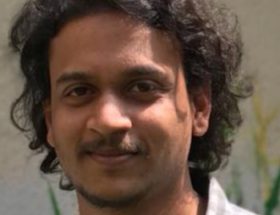Dr. Bhushan Amol Darkase
For the Veda is tainted by three faults of untruth, self-contradiction, and tautology. ~ Charvaka[1]
The 2022 calendar published by IIT Kharagpur with the theme of ‘Indian Knowledge Systems’ acknowledged on its front page in the first line- ‘Recognition of the secret of the Vedas.’ [2]
This fetish for the revival of the Vedic past is pervasive in all Brahmanized cultural institutions. This fetish, which is palpable from the 18th century onwards, is nothing but ‘rationalization’ which is ‘the conscious or unconscious tendency to put forward a secondary set of motives or an action, to cover up original ones which cannot be given social expression.’
A theory, doctrine, or scripture has to be evaluated for its effect upon human character & its impact on society. The Vedas’ sociological implications result in dire unjust consequences. If a theory, doctrine, or scripture carries the inherent potential to produce and reproduce the unjust subjectivity, it needs to be annihilated right from its foundational roots. Kant says, “Nothing can be regarded as good without qualification except a good will.”
Do the Vedas produce unjust subjectivity in a society? Do the Vedas carry goodwill?
The answer to the first question is Yes, and to the second is No.
In the words of Brian K Smith, Vedas define in explicit and implicit ways: “The framework for the caste system is laid out in the Veda itself. Caste thus derives at least part of its endurance and persuasiveness from the fact that it has canonical legitimacy.” [3]
“Canon and a particular form of social classification are part of creation itself according to Vedic cosmogenesis.” [3]
In simple language, Cosmos↔ Vedas ↔ Society.
Society (& its Varna stratification – author) becomes merely one expression of a universe created in the image of the Vedas. [3]
So the hierarchical social stratification is justified in the cosmic creation itself with the might of the Vedic scriptures.
Brian K smith shows in a detailed manner the various parameters on which the Vedas show hierarchical differentiation and imparting of different meters to each varna, with Brahmin as the head of the hierarchy.
Even without considering the interpolation of the infamous ‘Purusha Sukta,’ the Brahmanical blinkers of Vedas still confer legitimacy to hierarchy in society through cosmogenetic mutual linkage of the scripture and society.
The fluidity with which the other Brahmanical scriptures could justify the monstrous rules under the veneer of religion draws its legitimacy from Vedas. It proves that Vedas themselves carry the germs of inequality incipiently, ready to be activated through the other Bramhanical scriptures.
Like Dr. Ambedkar said, “For what is this sacred literature? It is a literature which is almost entirely the creation of the Brahmins.” [4]
The Brahmins, throughout history, had tried to adopt the most salient feature of every period and convert it into an ideology that strengthens their dominant position undisputedly.
In colonial times, adopting the ‘Aryan race theory’, without any moral consideration, suited their hierarchical domination.
What is the reason to refute the Aryan invasion theory?
Another question is, why now?
Answer to the first question, in the words of historian Romila Thapar, is that the question of who first stood on the soil is important to nationalists because “if the Hindus are to have primacy as citizens in a Hindu Rashtra (kingdom), their foundational religion cannot be an imported one.” [5]
The central tenet of this foundational religion is Brahmanism which is euphemized as Hinduism.
The answer to the second question (why now?) is that the process with its explicit manifestation started when the books with a clear sectarian bias were introduced in 2002.
In 2014, PM Narendra Modi appointed a committee (the 14-person committee and ministers) of scholars with the aims: 1} to use evidence such as archaeological finds and DNA to prove that today’s Hindus are directly descended from the land’s first inhabitants many thousands of years ago, and 2} make the case that ancient Hindu scriptures are fact, not a myth.[5]
The Committee’s creator, Culture Minister (in 2014) Mahesh Sharma, a doctor, and chairman of a chain of hospitals, said he received guidance from the RSS. [6] With an annual budget of about $400 million – an important source of federal funding for historical research, archaeology, and the arts – the Culture Ministry is an influential place to start a campaign of historical revision.[5]
One wonders why the RSS chief is talking suddenly about the DNA of all people in India has been the same for 40,000 years. But when you see the Committee’s first aim, it becomes clear. [6] Whether proven or not, a process has been started. IIT Kharagpur, a so-called elite institution, is publishing a calendar[2] to refute the ‘Aryan theory” based on the excerpts from Vedas. It is not incidental; it also harmonizes with the Committee’s second aim.
The DNA of all people in India has been the same for 40,000 years: this comment is not even worthy of attention. Like Tony Joseph, the author of ‘Early Indians’, said: “In fact, there is no living person anywhere in the world whose DNA profile exactly matches that of anyone who lived up to 40,000 years ago.” [7]
These developments are not only happening at higher levels, but the Vedas, Bhagvat Gita are being considered for inclusion even in the school curriculum*.
See the “331 report on reforms in content and design of school textbooks” by the Parliamentary Standing Committee on Education, women, children, youth & sports (Presented to the Rajya Sabha & Lok Sabha on November 30,2021) [8]
Most witnesses, organizations and subject experts who deposed before the committee (points 2.4. 2.5.) [8] shared right-wing or, to be specific, RSS ideology.
As one member of the Committee said, “No member raised objection as these were merely depositions, and there is no need for us to rectify their position.” [9]
Even though these were just depositions, the observations and recommendations of the Committee show their profound impact.
[See at the end of the article the ‘other organizations’ (who deposed before the Committee) and their ideological orientation. Everything is present in the public domain & the Internet.]
The Committee on Reforms in Content and Design of School Textbooks
Observations [8]
4.10 The Committee observes that in respect of the NCERT History syllabus, it was proposed that brief information regarding the other three Vedas, i.e., Samaveda, Yajurveda, and Atharvaveda, Bhagavad Gita, as Agam Literature should also be included along with Rigveda as they are also important sacred books. Further, some of the important teachings of all religious scriptures should also be adequately included in the textbooks.
- Recommendations [8]
5.15. The NCERT and SCERT should incorporate the ancient wisdom, knowledge, and teachings about life and society from Vedas and other great Indian Texts/ Books in the school curriculum.
5.16. The traditional Indian knowledge systems should be linked with modern science and presented in the contemporary context in NCERT textbooks.
5.18. All books, especially history books other than published by Government agencies, used for supplementary reading, maybe in consonance with the structure/ content of NCERT books to avoid discrepancies. Also, the Ministry of Education should develop a monitoring mechanism for ensuring the same.
The last recommendation is explicit censorship of history.
The National Curriculum Framework decides for the writing and development of textbooks. Given the New Education Policy 2020, the new National Curriculum Framework will be revised. The coming of the Standing Committee Report at this juncture is what makes it important.
I will borrow the words of G.Aloysius [10] to explain these state-sponsored developments in the cultural and educational sphere as, it could be readily seen that these characteristics themselves are interlinked as they constitute the different dimensions of a singular and unified point of view: ‘the deeper undercurrent, both in terms of ideology and the human agency behind it, as informing and effectively determining the ongoing social crisis.’
The RSS is the deeper undercurrent guiding the state and its ongoing cultural & educational counter-revolution.
As far as Vedas and Bhagvat Gita are concerned, Shudras and Dalits need to understand what was said by Dr. Ambedkar, ‘Nothing is to be gained in picking and choosing between them. The Philosophy of Hinduism will be the same whether one takes the Manu Smriti as its Gospel or whether one takes the Vedas and the Bhagvat Gita as the Gospel of Hinduism.’ [12]
To be more scathing in criticism of Vedas, Brihaspati says, “The Agnihotra, the three Vedas, the ascetic, three staves, and smearing oneself with ashes, ‘these are but means of livelihood for those who have no manliness nor sense.'” [1]
The right-wing accuses the Congress and left liberals for Marxist interpretation of Indian history, and in response, they charge the right-wing with communalization of history.
But, we need to ask, where is the history from the Dalit-Bahujan perspective in the Indian educational system?
Aloysius said that “The process, by which a monolithic Hindu collectivity was being created thus, had two complementary dimensions: it was an attempt to achieve dominance over the mass of people known within the Brahmanical* lore as Shudras and ati-Shudra castes but it was also a process of creation of recognizable and hence acceptable communal minorities. So both the branches stemmed out of a single root of the rise to dominance of the Brahmanical in the context of the emerging colonial modernity.” [10]
These educational and cultural textual alterations also point towards the same two-dimensional attempt for dominance over Shudras and Ati- Shudra castes through Vedic and religious indoctrination at the earliest stage of developmental years and exclusion of otherized minorities, especially Muslims and Christians, through the jingoism of historical facts. Forcing the way of life of some over the large masses is the most bizarre ideology Brahmanical core has achieved and tried to accomplish in every possible time of history.
As have been said above, A theory, doctrine, or scripture has to be evaluated for its effect upon human character &its impact on society. To summarize, no one has said better than Bertrand Russell, that “Instead of being encouraged in the practice of free inquiry, children are instructed in some brand of orthodoxy, with the result that unfamiliar ideas inspire them with terror rather than with interest.”
This orthodox imprinted educational ideological apparatus will produce docile students, devoid of the weapon of ‘free inquiry.
We need to remember that if the truth is the mother of History, then the free inquiry is the mother of truth.
While deliberating on the ‘Prospects of Democracy in India’, Dr. Ambedkar said, “Can education destroy caste? The answer is ‘YES’ as well as ‘No.’ If education is given as it is today, education can have no effect on caste. It will remain as it will be.” [12]
He was advocating for the education of lower strata, which was kept out of education by various sanctions. He considered lower strata to be more interested in blowing up the caste system because education would open their eyes to fight the caste system.
Currently, the universal availability of education and its potential to annihilate caste is rendered ineffective by inculcating the values (Vedas & other religious scriptures) with questionable moral foundations.
We need unsatisfied Socrates coming out of these institutions rather than satisfied fools˟. Dr. Ambedkar believed that education carries the potential to destroy caste. In that case, not only its universal availability to all but its pedagogical character or power to destroy caste needs to be evaluated, guarded, and decided in the light of the common good.
“To my knowledge, no class can hold State power over a long period without at the same time exercising its hegemony over and in the State Ideological Apparatuses.” – Louis Althusser.
One can only remember the report by Mahatma Phule to Hunter commission in which he said that: ‘It is no less the duty of each of my Shudra brethren as have received any education, to place before Government the true state of their fellowmen and endeavour to the best of their power to emancipate themselves from Brahmin thraldom.’
As have been said above, A theory, doctrine, or scripture has to be evaluated for its effect upon human character & its impact on society. To summarize, no one has said it better than Bertrand Russell: ‘Instead of being encouraged in the practice of free inquiry, children are instructed in some brand of orthodoxy, with the result that unfamiliar ideas inspire them with terror rather than with interest.’
This imprint of the orthodoxy on the educational ideological apparatus will produce docile students, devoid of the weapon of ‘free inquiry’.
We need to remember that if truth is the mother of history, then free inquiry is the mother of truth.
‘To my knowledge, no class can hold State power over a long period without at the same time exercising its hegemony over and in the State Ideological Apparatuses.’ -Loius Althusser.
Jai Bhim.
~
References
1} Riddles in Hinduism BAWS, Vol-4
2} IIT Kharagpur calendar 2022
3} Veda & Varna by Brian K Smith
4} Who were the Shudras? By Dr.B.R.Ambedkar
5} “By rewriting history, Hindu nationalists aim to assert their dominance over India”-By Rupam Jain and Tom Lasseter, March 6, 2018, Reuters Investigates
https://www.reuters.com/investigates/special-report/india-modi-culture/
6} For 40,000 Years, DNA Of All People In India Has Been Same: RSS Chief, https://www.ndtv.com/india-news/rss-chief-mohan-bhagwat-for-40-000-years-dna-of-all-people-in-india-has-been-same-2659194
7} RSS Chief Uses Debunked Myths To Hold Up Dangerous Fantasy of a ‘Pure Race’ the wire by Tony Joseph HTTPS://SCIENCE.THEWIRE.IN/THE-SCIENCES/RSS-CHIEF-DEBUNKED-MYTHS-DANGEROUS-FANTASY-PURE-RACE/
8]https://rajyasabha.nic.in/rsnew/Committee_site/Committee_File/ReportFile/16/162/331_2021_11_15.pdf
10} The Brahmanical Inscribed in Body-politic By G.Aloysius
11} Philosophy of Hinduism By Dr.B.R.Ambedkar
12} BAWS, Vol 17, Part 3, Pg 519-523
˟J.S. Mill- ‘Utilitarianism’: ‘It is better to be a human being dissatisfied than a pig satisfied; better to be Socrates dissatisfied than a fool satisfied. And if the fool, or the pig is of different opinion, it is only because they only know their own side of the question.’
~
SOME of the Other Organizations & Subject Experts who deposed their views on reforms in content and design of school textbooks to the Committee-
1] Bharatiya Shikshan Mandal
An offshoot of the Rashtriya Swayamsevak Sangh. BSM is on a mission to persuade educational institutions and governments to form frameworks that conform to Indian values.
BSM carried workshops to infuse research in Indian universities with the cultural purity of ‘Bharatiyata’ and conferences such as “Research for Resurgence,’ inaugurated by the then education minister Smriti Irani.
2] Shiksha Sanskriti Utthan Nyas (SSUN)
The Shiksha Sanskriti Utthan Nyas is supported by Rashtriya Swayamsevak Sangh (RSS).
Shiksha Sanskriti Utthan Nyas (SSUN) is headed by Dina Nath Batra.
https://economictimes.indiatimes.com/topic/shiksha-sanskriti-utthan-nyas
3] Vidya Bharati –
Vidya Bharati (Vidya Bharati Akhil Bharatiya Shiksha Sansthan) is the educational wing of RSS. It runs one of India’s largest private school networks. Special attention is given to underdeveloped areas & regions inhabited by tribal communities.
https://www.theweek.in/wire-updates/business/2019/10/24/pwr6–vidya%20bharati.html
Dina Nath Batra opposed the mention that Indo Aryans, including Brahmins, had consumed beef as a part of their diet in ancient times and eventually got it removed from NCERT books https://timesofindia.indiatimes.com/india/NCERT-books-have-no-mention-of-beef-eating/articleshow/1636172.cms
On the advice of Batra, the CM of Madhya Pradesh Shivraj Singh Chouhan removed sex education from the state curriculum because it offended Indian values. Batra advised that yoga be added to the curriculum instead of sex education. http://archive.indianexpress.com/news/madhya-pradesh-bans-sex-education/25871/
In 2008, Batra got Delhi University to drop A.K. Ramanujan’s essay, ‘Three Hundred Ramayanas,’ from the history syllabus. The paper discusses the many texts and presentations of the Ramayana that appear across the globe.
Gems from Batra’s book:
Pushpak vimana is the first airplane, Vedic maths is real mathematics, reject English and revert to the ancient language, our rishis were scientists whose inventions were appropriated by the west. https://www.hindustantimes.com/india/historians-slam-dina-nath-batra-s-books/story-K28lQrmoccBKPZ8s8ChnoM.html
On June 30, 2014, the Bharatiya Janata Party government of Gujarat issued a circular to all 42,000 primary & secondary schools in the state, declaring that Batra’s six textbooks were part of the state education curriculum supplementary literature. https://www.thehindu.com/news/national/dinanath-batra-man-behind-pulping-of-wendy-donigers-book-is-mustread-in-gujarat-schools/article6249539.ece
Historians had slammed Dina Nath Batra’s books and called them ‘works of fantasy.’ Irfan Habib said, “The point here is whether the person has any semblance of scholarship, any track record.”
4] Samvit Research Foundation, Bengaluru added many points out of which those representing history & Vedic view are described below:
The contribution of Veer Savarkar needs to be given enough weightage.
Our Itihāsas and Purāṇas, particularly the Rāmāyaṇa, have been an integral part of the culture of many regions of Southeast Asia.
They pressed the importance of the role played by a female in our History by exposing the children to factual information from the past:-
Introduce the three great goddesses of the Vedas – Bhāratī, Ilā, Sarasvatī. Introduce a few Veda-suktas for which women are the mantra-draṣṭāriṇīs.
In the Vedic period, mention woman scholars, brahmavādinīs, and mantra-draṣṭāriṇīs, including instances of where women learned the Vedas.
Present the dynamic role played by women in the Rāmāyaṇa and Mahābhārata. Give a complete picture of women-related references in the smṛtis
One wonders what pictures of women references from smritis will be depicted?
5] Prof. J.S. Rajput, Former Director, NCERT
During his tenure, J.S.Rajput spearheaded a process of controversial textbook revision, which critics have slammed as a communalisation of Indian history. history.https://www.thehindu.com/news/national/mughal-history-whitewashed-in-textbooks-educationists-tell-house-panel/article33570951.ece
* Another example
Delhi: SDMC proposes teaching Bhagavad Gita in its schools https://indianexpress.com/article/cities/delhi/sdmc-proposes-teaching-bhagavad-gita-in-its-schools-7680847/
RSS ideologue Dinanath Batra to guide Haryana on education https://web.archive.org/web/20141112194629/http://www.hindustantimes.com/india-news/rss-ideologue-dinanath-batra-to-guide-haryana-on-education/article1-1285430.aspx
(The entire technical and other aspects are not criticized, but only the ideological orientation is evaluated from depositions by other organizations and subject experts )
~
Dr. Bhushan Amol Darkase is an Assistant Professor in VDGMC Latur and has an M.D. Dermatology, and Fellowship in Diagnostic Dermatology.










